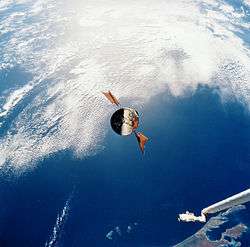High Speed Photometer

The High Speed Photometer (HSP) was a scientific instrument installed on the Hubble Space Telescope. The HSP was designed to measure the brightness and polarity of rapidly varying celestial objects. It could observe in ultraviolet, visible light, and near infrared at a rate of one measurement per 10 microseconds. The design was novel in that despite being able to view through a variety of filters and apertures, it had no moving parts except for the filter wheel.[1]
The HSP was one of the instruments on Hubble at launch. Its primary mission was compromised by the optical problems with the telescope, although some projects were still successful. During the first servicing mission, in December 1993, it was replaced by the Corrective Optics Space Telescope Axial Replacement (COSTAR), which corrected the optical problem for the remaining instruments.
Notes
Further reading
Bless, R. C.; Richards, E. E.; Bosh, A.; Dolan, J. F.; Elliot, J. L.; Nelson, M.; Percival, J. W.; Robinson, E. L.; Taylor, M.; Van Citters, G. W.; White, R. L. (1999). "The Hubble Space Telescope's High‐Speed Photometer". Publications of the Astronomical Society of the Pacific. 111 (757): 364–375. Bibcode:1999PASP..111..364B. doi:10.1086/316334.
External links
- HSP Information at STSCI
- Instrument Handbook
- HSP at the University of Wisconsin's Space Astronomy Laboratory